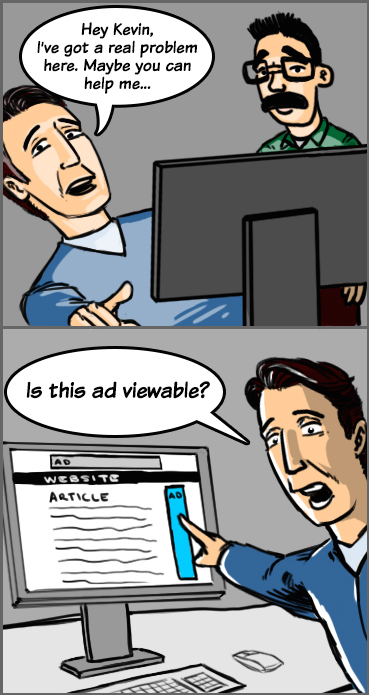
This article was written by Jonathan Slavin, Chief Revenue Officer, CPXi
In November 2012, the Media Rating Council (MRC) issued an advisory against transacting on viewable impressions as a currency metric. The MRC then began to conduct pilot tests and work on developing standards for viewable impression measurement. It took until the end of June 2014 for the council to issue guidelines on how to measure viewability.
Given the way business continues to be conducted, it’s clear that we as an industry have yet to reach a consensus on what a “viewable” ad is. And because advertisers are already on high alert due to fraudulent activity, that lack of consensus causes disputes over whether or not ads are legitimately being viewed.
At CPXi, we’ve had advertisers cry “fraud” because their ad — which was designed to be served above the fold — fell out of view when the viewer scrolled down. This kind of confusion over what constitutes “viewability” makes advertisers feel like they’re being cheated, and it puts those of us on the supply side of the industry in an adversarial position.
Many of these disputes can be chalked up to a lack of education.
In a recent Adap.tv survey of 350 media and marketing professionals, 42 percent of both ad buyers and sellers said they feel they’re not well-informed about ad viewability. When asked about their stated concerns about viewability, ad verification/placement and ad fraud, only 25 percent characterized themselves as being up to speed on these issues.
It’s not as if the information isn’t out there. The MRC Viewable Ad Impression Measurement Guidelines, which were designed to supplement the IAB’s existing standards on display and video advertising, were issued nearly four months ago.

Here are the highlights.
Viewable browser space
Long been defined as the topmost part of a given web page, this space is traditionally known as “above the fold.” However, as MRC acknowledges, this area depends on the user’s settings for resolution, font size, window size and so forth.
“Upon initial page load, advertising or content placed at the top and left side of the page is most likely to be viewable,” the MRC states. “However, this can change if content or ads are obscured by overlays or with further user action (scrolling) coupled with latency; therefore, placement and viewable status are separate attributes to be assessed.”
Viewable ad impression
A viewable ad impression is defined as one in which the viewer has a legitimate opportunity to see the ad in question, which may or may not be the case with a served ad impression.
Invalid impressions
Impressions that do not meet certain ad serving quality or completeness criteria, or otherwise do not represent legitimate ad impressions that should be included in impression counts, are considered invalid.
Such impressions may be the result of non-human traffic (spiders, bots, etc.), or other activity designed to produce fraudulent impressions.
Fraudulent impressions
Those impressions that “result from an intentionally deceptive practice designed to manipulate legitimate ad serving or measurement processes or to create fictitious activity that leads to inflated counts” are considered fraudulent.
MRC continues: “All fraudulent impressions are invalid (but not all invalid impressions are fraudulent), and impressions known to be fraudulent can never be viewable impressions.”
Key concepts
When counting viewable ad impressions, the following key concepts of previously established IAB guidelines for served ad impressions should be employed:
- client-side counting;
- filtration of non-human activity and invalid activity;
- cache-busting techniques;
- differentiating significant auto-refresh from human-initiated activity;
- differentiation of impressions served in situations of out-of-focus or obstruction;
- disclosure of material internal traffic; and
- full disclosure by publishers, portals, ad-servers, ad networks and exchanges.
Still with us?
The point is: Viewability isn’t the best choice of metrics.
Unless fraud is involved, no ad is literally “non-viewable” when it’s served. Rather, the metric seeks to identify whether the ad was actually viewed.
Regardless, the “opportunity to see” an ad is nowhere near as important, for example, as whether the viewer engaged with it. Users are guided by content, and if that content entices them to scroll down, then voila! They’ve been served another viewable ad.
This is not rocket science, and the fact that so many people don’t yet grasp the meaning of viewability indicates that we’re making things harder than they need to be.
I appreciate that many intelligent, dedicated professionals have devoted two years to this issue. But maybe it’s time to go back to the drawing board and come up with better units of measurement that more accurately reflect an advertiser’s KPI.
After all, we’re in the business of interactive advertising, not “possibly viewed” advertising.
More from Digiday

Inside the debate among marketers for and against virtual influencers
The rise of AI and the growth of the creator economy have sparked a resurgence in marketers’ interest in these digital personas.

IPG’s former data chief Arun Kumar: How data collection can be improved without too much regulation
In his book, The Data Deluge, which comes out next week, Kumar argues that as data and data collection and analysis got more sophisticated, somewhere along the way, ethics took a backseat.

After latest cookie delay, Google tells ad tech there will be ‘gradual ramp up’ but eschews specifics
It’s been two weeks (ish) since Google announced the third delay to its long-gestating plan to rid it’s browser of third-party cookies — just about enough time to get over the shock of the utterly predictable.





